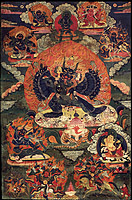
|
Tutelary Deity Yamantaka (painting no. 614)
|

View Larger Image |
||||||||||||||
|
Vajra Bhairava (Tibetan: dorje jig-je. Eng.: Vajra Terror) with the consort Vajra Vetali (Tib.: dorje rolangma). Bhairava is dark blue in colour with 9 faces, 32 hands and 16 legs. The main face is that of a buffalo, with a red face above and the slightly angry yellow face of Manjushri placed on top. Flames shoot from the tips of the horns. The three right faces are yellow, blue and red and the three left are black, white and smoky. Each face has three eyes, bared fangs and frightful expressions; yellow hair flows upward like flames. The first pair of hands hold a curved knife and skullcup to the heart embracing the consort. The remaining hands hold a multitude of weapons with the last pair holding in addition the outstretched hide of an elephant. He is adorned with interlaced bone ornaments, a necklace of snakes and a long necklace of fifty heads. The consort, Vajra Vetali (Zombie), with one face and two hands holds a skullcup and embraces Bhairava. The right legs are bent pressing down on a man, animals and various gods. The left legs are extended straight and press upon eight birds and various gods; standing above a yellow sun disc and multi-coloured lotus completely surrounded by the orange flames of pristine awareness. In front of the lotus throne is a large skullcup, on a tiger skin mat, filled with various offerings. At the top center is the buddha Vajradhara, blue, with the two hands holding a vajra and bell to the heart; seated in vajra posture. To the left is wrathful Vajrapani, blue, with one face and two hands. Below that is Sadbhuja Mahakala, black, with one face and six hands standing on a white elephant. To the right of Vajradhara is ‘Secret Accomplishment’ Hayagriva, red in colour, with three faces and six hands. Below that is Palden Magzor Gyalmo, blue-black, with one face and two hands; riding a mule. To the left is Yama Dharmaraja, blue-black, with the head of a buffalo, holding a bone stick in the right hand and a lasso aloft with the left. Embraced by the consort Chamundi, he rides on the back of a black buffalo; surrounded by flame. Yama is the special protector for the central figure, Vajra Bhairava. To the right side is the guardian of the northern direction, Vaisravana, yellow in colour with one face and two hands holding a banner and mongoose; riding a white snow lion with green hair. Below that is the avowed protector Tsi’u Marpo, red, with one face and two hands, attired in the garb of a soldier; riding a horse, holding a spear in the right hand and dragging a small figure by a lasso held in the left. To the left is another protector in the same garb, red in colour, holding a spear and bow; in a standing manner. In the left corner is Damchen Garwa’i Nagpo, blue in colour, with one face and two hands, holding a hammer in the right and a blacksmith’s bellows made of tiger skin in the left hand; riding a goat. As a tutelary deity Vajra Bhairava, also known as Yamantaka, belongs to the Yamari class of tantras and specifically arises from the Vajra Bhairava Root Tantra (Tibetan: Jig je tsa gyu). All of those belong to the method (father) classification of Anuttaryoga Tantra. There are numerous forms and styles of practice from the very complex to the very concise with a single Heruka form. The main lineages to enter Tibet were those of Jowo Atisha, Rwa Lotsawa, Mal Lotsawa and the like. This form of Bhairava with the central faces placed 3 vertically and 3 faces to each side arranged horizontally is unique to the Gelugpa School and true to a visionary experience of Lord Tsongkhapa the founder. Lineage: Shri Vajra Bhairava, Jnana Dakini, Mahasiddha Lalitavajra, Amoghavajra, Yeshe Jungne Bepa, Mahasiddha Padmavajra, Marmedze Srungwa, Rwa Lotsawa Dorje Drag, Rwa Chorab, Rwa Yeshe Senge, Rwa Bum Seng, Rongpa Gwalo Namgyal Dorje, Rongpa Sherab Senge, Lamdrepa Yeshe Palwa, Je Sonam Lhundrup, Choje Dondrup Rinchen, Je Tsongkhapa Lozang Trakpa (1357-1419), etc. J.Watt 8-98
|
|||||||||||||||
Photographed Image Copyright © 1998 Shelley & Donald Rubin Foundation
|
|
| |
Next Image |